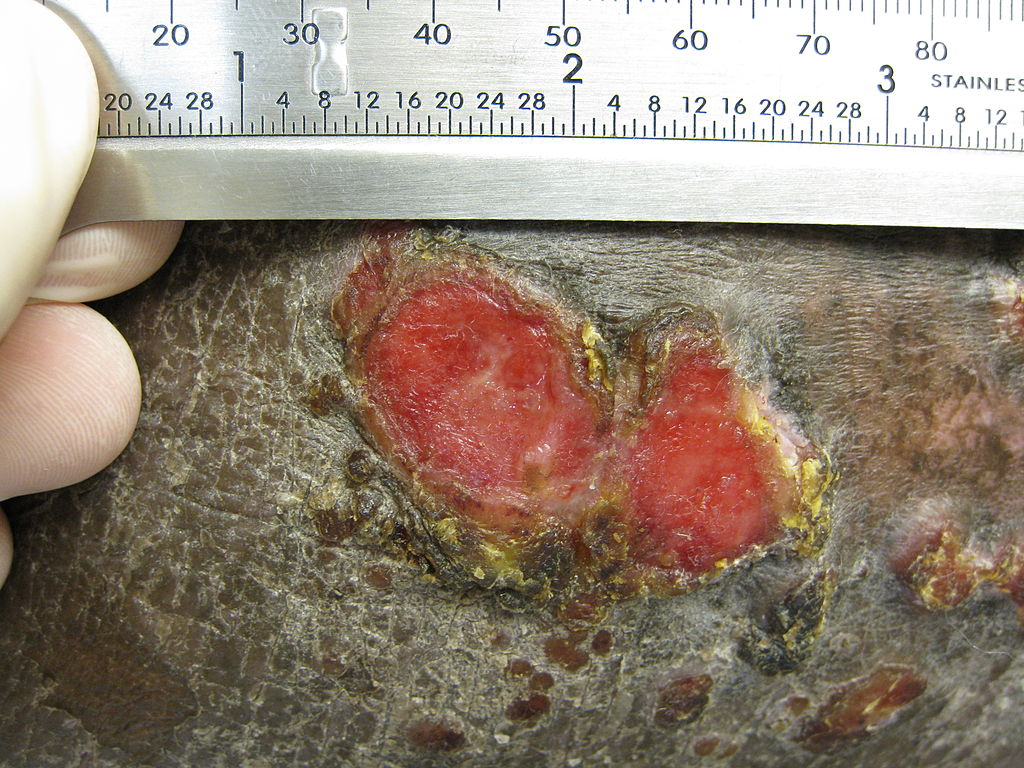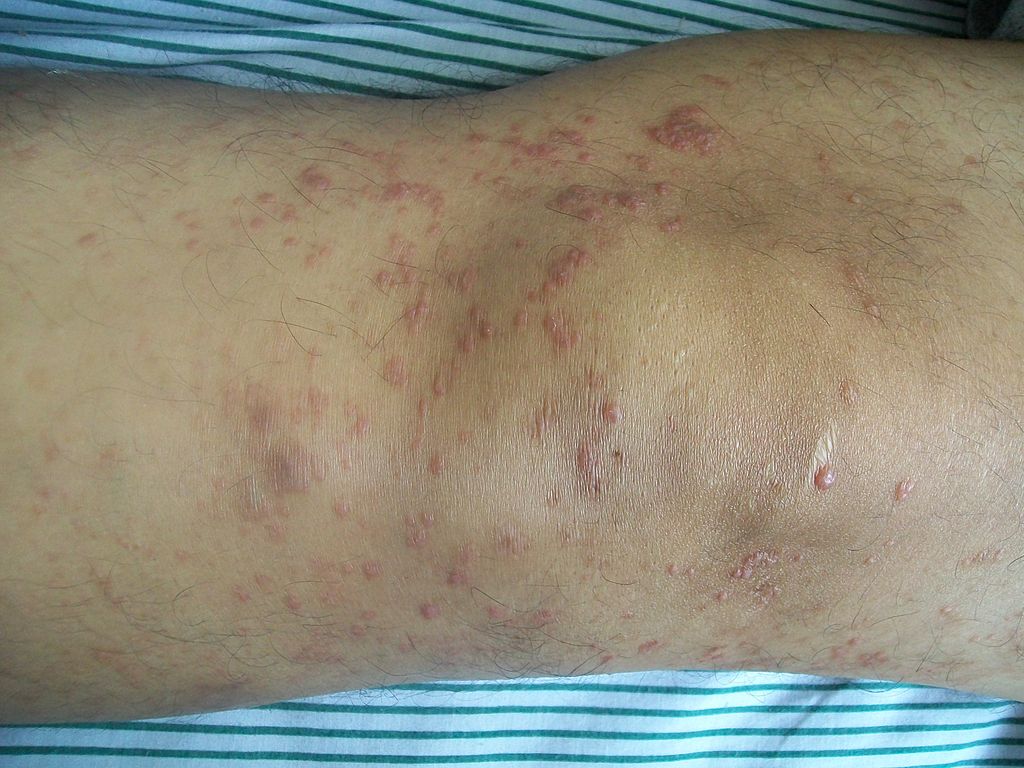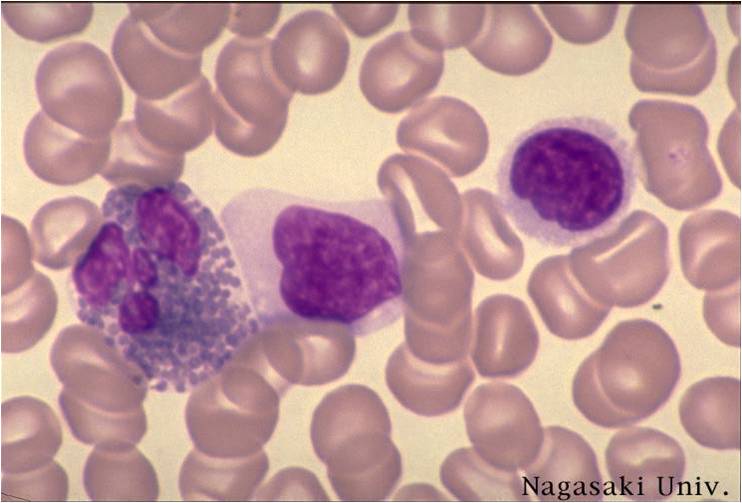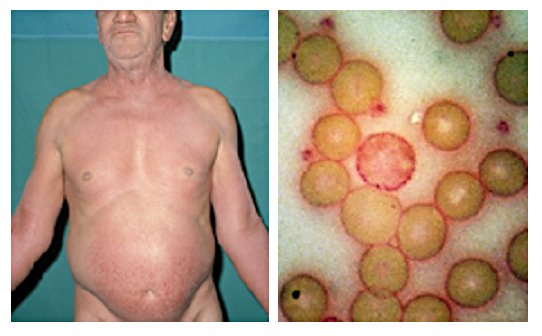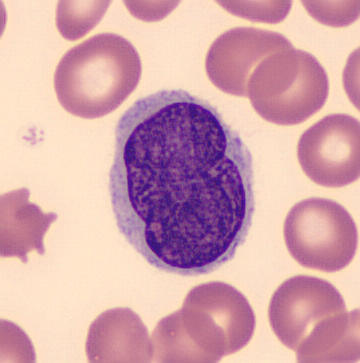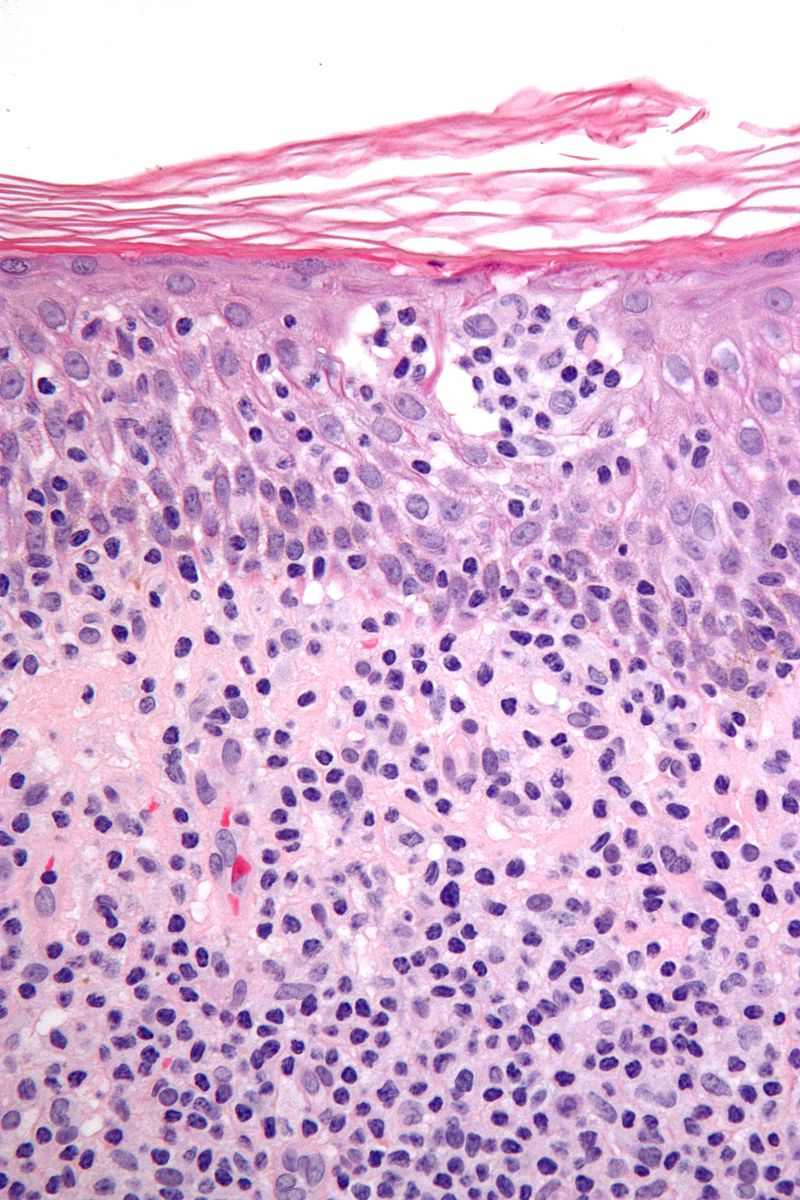Mycosis fungoides pathophysiology: Difference between revisions
(Mahshid) |
|||
| Line 5: | Line 5: | ||
Cutaneous T cell lymphoma arises from [[T-cell]] lymphocytes, which are normally involved in the cell mediated immune response. On microscopic histopathological analysis, atypical [[lymphoid]] cells, [[polymorphous]] inflammatory infiltrate in the dermis, and [[lymphocytes]] with cerebroid nuclei are characteristic findings of mycosis fungoides. | Cutaneous T cell lymphoma arises from [[T-cell]] lymphocytes, which are normally involved in the cell mediated immune response. On microscopic histopathological analysis, atypical [[lymphoid]] cells, [[polymorphous]] inflammatory infiltrate in the dermis, and [[lymphocytes]] with cerebroid nuclei are characteristic findings of mycosis fungoides. | ||
==Pathophysiology== | ==Pathophysiology== | ||
* Cutaneous T cell lymphoma arises from [[T-cell]] lymphocytes, which are normally involved in the cell mediated immune response. | * Cutaneous T cell lymphoma arises from [[T-cell]] lymphocytes, which are normally involved in the cell mediated [[immune]] response. | ||
* Sezary syndrome and mycosis fungoides are T-cell lymphomas that primary manifest as multiple cutaneous lesions. | * Sezary syndrome and mycosis fungoides are T-cell lymphomas that primary manifest as multiple cutaneous lesions. | ||
* Mycosis Fungoides is the most common type of [[cutaneous T cell lymphoma]]. | * Mycosis Fungoides is the most common type of [[cutaneous T cell lymphoma]]. | ||
| Line 13: | Line 13: | ||
==Gross Pathology== | ==Gross Pathology== | ||
* On gross pathology, irregular, erythematous, circular patches are characteristic findings of cutaneous T cell lymphoma. | * On gross pathology, irregular, erythematous, circular patches are characteristic findings of cutaneous T cell lymphoma. | ||
<gallery widths=200px> | <gallery widths="200px"> | ||
Image:Plaque of mycosis fungoides 1.jpg| Plaque of mycosis fungoides | Image:Plaque of mycosis fungoides 1.jpg| Plaque of mycosis fungoides | ||
Image:Mycosis fungoides knee.JPG| Mycosis fungoides knee | Image:Mycosis fungoides knee.JPG| Mycosis fungoides knee | ||
| Line 32: | Line 32: | ||
:* Expansion of the [[dermis]] due to dense infiltration by medium sized [[lymphocytes]] that are typically characterized by a cerebroid nuclei. | :* Expansion of the [[dermis]] due to dense infiltration by medium sized [[lymphocytes]] that are typically characterized by a cerebroid nuclei. | ||
<gallery widths="200px"> | |||
<gallery widths=200px> | |||
Image:Sezary syndrome 0001.jpg| Sézary's disease | Image:Sezary syndrome 0001.jpg| Sézary's disease | ||
Image:Sézary's disease- PAS stain.jpg| 61-year-old man presented in 1972 with unrelenting pruritus of six months’ duration. On the right is his peripheral blood film stained with Periodic Acid-Schiff (PAS) showing a neoplastic T cell (Sézary cell). | Image:Sézary's disease- PAS stain.jpg| 61-year-old man presented in 1972 with unrelenting pruritus of six months’ duration. On the right is his peripheral blood film stained with Periodic Acid-Schiff (PAS) showing a neoplastic T cell (Sézary cell). | ||
Revision as of 20:34, 31 October 2018
|
Cutaneous T cell lymphoma Microchapters |
Editor-In-Chief: C. Michael Gibson, M.S., M.D. [1]; Associate Editor(s)-in-Chief: Sowminya Arikapudi, M.B,B.S. [2]
Overview
Cutaneous T cell lymphoma arises from T-cell lymphocytes, which are normally involved in the cell mediated immune response. On microscopic histopathological analysis, atypical lymphoid cells, polymorphous inflammatory infiltrate in the dermis, and lymphocytes with cerebroid nuclei are characteristic findings of mycosis fungoides.
Pathophysiology
- Cutaneous T cell lymphoma arises from T-cell lymphocytes, which are normally involved in the cell mediated immune response.
- Sezary syndrome and mycosis fungoides are T-cell lymphomas that primary manifest as multiple cutaneous lesions.
- Mycosis Fungoides is the most common type of cutaneous T cell lymphoma.
- Sézary's cells are T-cells that have pathological quantities of mucopolysaccharides.
- Sézary's disease is sometimes considered a late stage of mycosis fungoides.
Gross Pathology
- On gross pathology, irregular, erythematous, circular patches are characteristic findings of cutaneous T cell lymphoma.
-
Plaque of mycosis fungoides
-
Mycosis fungoides knee
Microscopic Pathology
- Mycosis fungoides pathological course may be divided into three main stages:
- Premycotic stage
- Mycotic stage
- Tumoros stage
- The premycotic stage
- Non-diagnostic and represented by chronic nonspecific dermatisis associated with psoriasiform changes in epidermis
- The mycotic stage
- Shows a polymorphous inflammatory infiltrate in the dermis that contains small numbers of frankly atypical lymphoid cells
- These cells may line up individually along the epidermal basal layer
- The presence of spongiosis is highly suggestive of mycosis fungoides
- Tumoros stage
- Expansion of the dermis due to dense infiltration by medium sized lymphocytes that are typically characterized by a cerebroid nuclei.
-
Sézary's disease
-
61-year-old man presented in 1972 with unrelenting pruritus of six months’ duration. On the right is his peripheral blood film stained with Periodic Acid-Schiff (PAS) showing a neoplastic T cell (Sézary cell).
-
Pleomorphic abnormal T cell with the characteristic cerebriform nuclei (Peripheral blood - MGG stain)
-
Features: Nests of lymphocytes in the epidermis; "Pautrier microabscesses". Single lymphocytes in epidermis; "lymphocyte exocytosis". Short linear arrays of lymphocytes along the basal layer of the epidermis; "epidermotropism".
